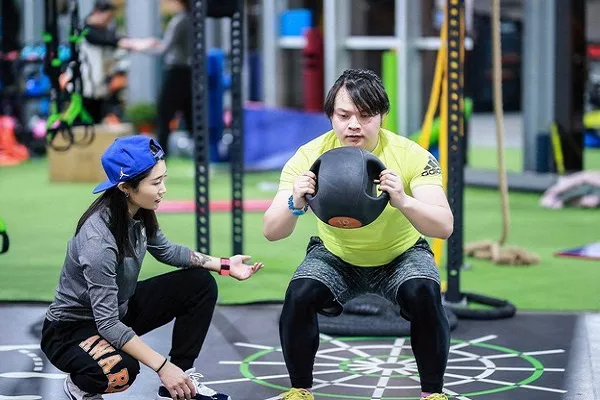Strength training is an essential component of any fitness program, and it has been shown to have numerous benefits, including increased muscle strength and power, improved bone density, enhanced metabolic function, and reduced risk of chronic diseases such as cardiovascular disease, diabetes, and certain types of cancer. However, one common question among individuals who engage in strength training is how long each session should be for optimal results. In this article, we will explore the evidence-based approach to determining the duration of strength training sessions.
The American College of Sports Medicine (ACSM) recommends performing strength training exercises at least two days per week, targeting all major muscle groups including the chest, back, arms, shoulders, legs, and core. Each exercise should consist of 1-3 sets of 8-12 repetitions, with a rest period of 30-90 seconds between sets. This recommendation is based on the consensus of several studies, and it has been shown to be an effective way to improve muscular strength and endurance in healthy adults.
However, the duration of each strength training session can vary depending on individual goals and factors such as age, sex, and fitness level.
General Fitness and Health Maintenance
For general fitness and health maintenance, a typical strength training session can last anywhere from 30-60 minutes. This will allow individuals to target all major muscle groups, improve overall strength and endurance, and reduce the risk of injury. Full-body workouts can be performed using compound exercises that work multiple muscle groups simultaneously, such as squats, deadlifts, and push-ups. These exercises are time-efficient and can be modified to suit different fitness levels.
In addition to strength training, it is recommended to engage in other forms of physical activity such as cardio, stretching, and mobility exercises. This will help to improve overall fitness and health, reduce the risk of chronic diseases, and enhance overall quality of life. The ACSM recommends engaging in at least 150 minutes of moderate-intensity aerobic exercise per week, along with two days of strength training.
Muscle Mass and Strength Gains
For individuals who are looking to gain muscle mass or improve muscular strength, a longer duration of training may be necessary. This can involve performing more sets and repetitions of each exercise, increasing the weight lifted, or reducing the rest periods between sets. Generally, individuals should aim to train each muscle group at least twice per week, with a minimum of 48 hours of rest between sessions to allow for adequate recovery.
The amount of time required to build muscle can vary depending on factors such as age, sex, and genetics. However, research has shown that performing three to six sets of each exercise, with a repetition range of 6-12, is an effective way to stimulate muscle growth in healthy adults. Additionally, incorporating exercises that target specific muscle groups, such as bicep curls or calf raises, can help to increase muscle size and definition in those areas.
To maximize muscle hypertrophy and strength gains, it is important to progressively overload the muscles over time. This can involve increasing the weight lifted, performing more sets or repetitions, or reducing the rest periods between sets. It is also important to incorporate a variety of exercises and training modalities, such as free weights, machines, and bodyweight exercises, to ensure that all muscle groups are targeted and stimulated.
Power and Performance
Athletes who participate in sports that require high levels of strength and power, such as football, wrestling, and weightlifting, may require longer strength training sessions to achieve their goals. These individuals typically engage in specific strength training programs that are tailored to their sport and performance goals. These programs often involve lifting heavier weights, performing more advanced exercises, and focusing on specific aspects of strength and power development, such as explosive movements and plyometrics.
To improve power and performance, it is important to incorporate exercises that mimic the movements and demands of the sport or activity. This can include exercises such as power cleans, snatches, jumps, and sprints, which require high levels of force and speed production. It is also important to periodize the training program to ensure that the athlete is peaking at the appropriate time and avoiding overtraining and injury.
Nutrition and Recovery
In addition to the duration of strength training sessions, it is also important to consider proper nutrition and recovery strategies. Adequate protein intake is essential for muscle growth and repair, and individuals should aim to consume approximately 1 gram of protein per kilogram of body weight per day. Additionally, proper rest and recovery are crucial components of any fitness program, as they provide the body with the energy and nutrients needed to recover and adapt to the stress of exercise.
Conclusion
Ultimately, the duration of a strength training session depends on individual goals and factors such as age, sex, and fitness level. For general fitness and health maintenance, a typical session can last anywhere from 30-60 minutes, while individuals who are looking to gain muscle mass or improve muscular strength may require longer sessions. Athletes who participate in high-performance sports may also require specific strength training programs that are tailored to their performance goals.
Regardless of the duration of each session, it is important to progressively overload the muscles over time, incorporate a variety of exercises and training modalities, and prioritize proper nutrition and recovery strategies for optimal results. By following an evidence-based approach and tailoring the duration of strength training sessions to individual needs and goals, individuals can maximize the benefits of this essential component of any fitness program.
Related topics:


